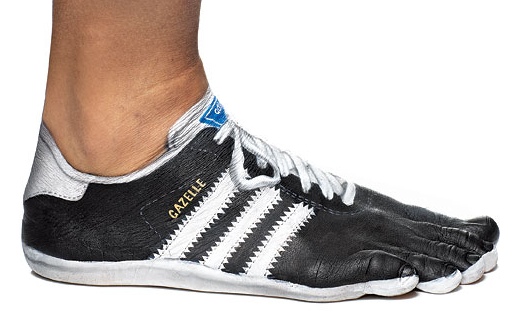This is a great article that offers a broad perspective on barefoot walking and running. I look at it as a case for change that is about to mature itself out of the pool of visionaries and early adopters. Barefoot walking and running is entering the zone of pragmatists. Being an early adopter myself of Vibram FiveFinger running shoes I am following this paradigm shift from closer by and I have blogged about it earlier. From what I can tell is that – over the course of the past year – people around me have gone from looking away or laughing to being interested in the shoes I am wearing.

People are not yet thinking about buying a pair for themselves (taking action) and I will be looking closely at the different stages that will come between being interested and applying that knowledge to oneself. So here we are: ‘laughing at’ has become ‘being interested in’. I’ll keep you posted on my next observations. In the mean time, enjoy the article. Here are some quotes that I take away for myself:
One of the lead researchers, Dr. Bernhard Zipfel, when commenting on his findings, lamented that the American Podiatric Medical Association does not “actively encourage outdoor barefoot walking for healthy individuals. This flies in the face of the increasing scientific evidence, including our study, that most of the commercially available footwear is not good for the feet.”
So it’s a bit surprising when he says, “Shoes are the problem. No matter what type of shoe. Shoes are bad for you.”
But shoes aren’t designed to be very flexible. Sure, you can take a typical shoe in your hands and bend it in the middle, but that bend doesn’t fall where your foot wants to bend; in fact, if you bent your foot in that same place, your foot would snap in half. So to compensate for this lack of flexibility, shoes are built with toe springs to help rock you forward. You only need this help, of course, because you’re wearing shoes.
The sole of your foot has over 200,000 nerve endings in it, one of the highest concentrations anywhere in the body. Our feet are designed to act as earthward antennae, helping us balance and transmitting information to us about the ground we’re walking on.
Most shoes, even running shoes, have a fairly substantial heel built into them. And heels, we now know, can increase knee load.” Another factor, she points out, is that when your foot can feel the ground, it sends messages to the rest of your body. “Your body tells itself, My foot just hit the ground, I’m about to start walking, so let’s activate all these mechanisms to keep my joints safe. Your body’s natural neuromechanical-feedback mechanisms can work to protect the rest of your extremities. You have much more sensory input than when you’re insulated by a thick outsole.”
In a 1997 study, researchers Steven Robbins and Edward Waked at McGill University in Montreal found that the more padding a running shoe has, the more force the runner hits the ground with: In effect, we instinctively plant our feet harder to cancel out the shock absorption of the padding.
I too have learned one thing—that if you’re interested in learning about barefoot walking, or the “barefoot lifestyle,” as it’s sometimes called, there are lots of people out there who are interested in teaching you.
Follow these enthusiasts too far, though, and you fall down a rabbit hole of eccentricity.
Still, while I can accept that barefoot-walking is beneficial, it’s hard to shake off 30 years of wrapping my feet in foam.
What you can do, though, is stop taking walking for granted and start thinking of it like any other physical activity: as something you can learn to do better.
It’s like driving a stick shift after years at the wheel of an automatic—you suddenly feel in control of an intricate machine, rather than coasting on cruise control. Now I better understand what Walt Whitman meant when he wrote (and I hate to quote another Transcendentalist, but they were serious walking enthusiasts): “The press of my foot to the earth springs a hundred affections.”


